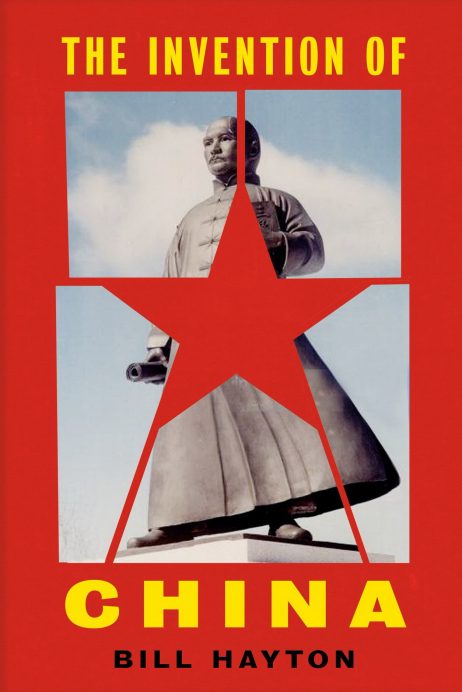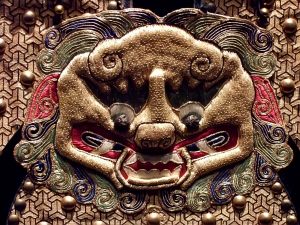Chinese leaders like to claim that their nation boasts a 5,000-year history as a unified state, drawing an implicit (and sometimes explicit) contrast between this ancient heritage and “newer” upstart powers like the United States. In a compelling and provocative new book, the U.K.-based author Bill Hayton reveals the extent to which this claim is the product of a modern process of nation-building.
In “The Invention of China” (Yale University Press, 2020), Hayton argues that the modern notion of “China” dates to the late nineteenth and early twentieth centuries, when reformers and revolutionaries adapted foreign ideas in order to fortify China against the depredations of Western imperialism. Hayton shows how this nation-building project, projected backward onto the various empires and states that occupied the present-day territory of the People’s Republic, planted the seeds of many of the country’s most fraught problems, from Xinjiang to Taiwan to the South China Sea.
Hayton, an associate fellow with the Asia-Pacific Programme at Chatham House and the author of two previous books on contemporary Vietnam and the disputes in the South China Sea, speaks with The Diplomat’s Southeast Asia Editor Sebastian Strangio about how China’s process of national invention continues to influence the country’s policy and international behavior.
What prompted you to begin excavating the foundations of Chinese nationalist myth-making?
This book grew out of my research into the history of the South China Sea. The more I looked into the origins of China’s territorial claims there, the more I realized that nationalists and officials in the 1930s were just making things up! The whole process was marked by mistakes, confusion and calculations based upon what was politically expedient at the time.
The more I read, the more I realized that the whole idea of “Chinese territory” was far more vague and incoherent than I had previously believed. And once I began to see the Qing state as a non-Chinese empire that was turned inside out by the nationalist revolution of 1911/12, I came to understand how much of the belief system that underpins Modern China was also constructed or invented in the late nineteenth and early twentieth centuries. Almost everything in the book is based on recent research and is known to academic specialists – I wanted to make it known to the population at large.
As you acknowledge in the book’s introduction, a process of national “invention” has been central to many (if not all) other nations. All of these have involved the spinning of national myths; many have also involved varying degrees of cosmetic alteration to the historical record, as well as willed acts of forgetting. Is there anything that makes the case of China unique? Is China’s myth-making exceptional?
All nation-states are, to use Benedict Anderson’s phrase, “imagined communities.” It was the French thinker Ernest Renan who said, back in 1882, that forgetting “is an essential factor in the creation of a nation” and selective remembering is just as important. In this, China is no different from any other state. But even this fact will, I think, be revelation to many people. There is a common belief that China is “different” from every other state, that it is more “ancient,” and more “real” than all the rest.
In my book I show how thinkers such as the reforming journalist Liang Qichao and the revolutionary activist Zhang Binglin actively created new narratives. They borrowed European ideas of race and nation and mixed them with their own views of the past – selectively remembering and forgetting historical evidence in order to justify the existence of a new state that could inherit the population and territory of an older – and very different – state.
The Qing Empire was a Manchu-run state. “China proper” – the former Ming state which the Qing invaded in 1644 – was just one part of it. The nationalists had to invent reasons why the non-Chinese parts – Tibet, Xinjiang, Mongolia and Manchuria – should remain part of this new country. People like Zhang Binglin would have been happy to discard the outer regions and focus on an “ethnically pure” center. Liang Qichao and Sun Yat-sen wanted to keep all the territory. This, ultimately, is the cause of the current unrest in Xinjiang, Tibet and even Inner Mongolia.
One of the things that is striking about China’s foreign policy is its zealous focus on the norm of national sovereignty, something that you refer to as “sovereignty fundamentalism.” How do you explain China’s fetish for sovereignty? What do you think this implies about the sort of international order that China’s current leadership would like to see?
I look at this in two ways – through the translation of the Western idea of “sovereignty” into the Qing Empire in the 1860s and then through the way a sense of “national humiliation” over the loss of territory was deliberately cultivated in the early twentieth century as a means of binding the new Republic of China together.
The Qing Empire presented several faces to the world. The emperor presented himself as a beile to the Manchu, a khan to the Mongols and a Buddhist patron to Tibetans, but in his Sinitic identity the emperor had to appear as the ruler of “all under heaven.” The court knew this was a fiction: it agreed to a frontier between its Manchu and Mongol lands and the Russian Empire in 1688, for example. However, the pretense was maintained.
It was the attacks by Europeans and Americans on “China Proper” after 1840 and then defeat by Japan in the war of 1895 that forced the Qing to engage with the outside world on new terms. I think those clashes fused pre-existing Sinitic ideas of an “all-powerful” ruler with Western ideas of the separateness of states to create an idea of sovereignty as a moral order rather than simply a legal arrangement. In contemporary China, it seems that sovereignty is defended as a moral imperative, a matter of life and death, rather than a convenient way to organize a complex international society.
We also need to add in the way that the Guomindang/KMT leadership deliberately used fear of the loss of territory in the 1920s and 1930s to rally political support. The teaching of geography and history were deliberately organized to educate children, and the wider society, about the country’s “national humiliation.” Taking all these elements of modern China’s development together it is possible to understand why contemporary leaders become so determined to possess specks of rock in the South China Sea or rocky riverbanks in the Himalayas. Ironically, they’re perpetuating a territorial fetish that Europeans abandoned decades ago.
 The claim that China boasts an unbroken history stretching back 5,000 years is a familiar and hoary trope of PRC propaganda. What political function does this claim to continuity serve?
The claim that China boasts an unbroken history stretching back 5,000 years is a familiar and hoary trope of PRC propaganda. What political function does this claim to continuity serve?
Almost every state has a history that goes back at least 5,000 years in the sense that people have inhabited most of the earth’s surface for at least that long. The claim of a 5,000 year history for China is intended to link it to the mythical birth-date of the mythical “Yellow Emperor” in 2698 BCE. The Yellow Emperor was chosen as the spiritual father of all Chinese by the man who invented the idea of the “Han Race” in 1900, Zhang Binglin. Zhang wanted to create a racial boundary between the Manchu rulers of the Qing Great State and the people he defined as the “Han” and he did so in his Qiushu (the “Book of Urgency”) in which he traced the origin of all the Han to the Yellow Emperor.
This is a racial vision in which all true Chinese are descendants from a single ancestral stock. It is one that it is quite at odds with all the empirical evidence from genetic and linguistic research on the very diverse population of the People’s Republic of China. Nonetheless, it seems to underpin Xi Jinping’s “steamroller” approach to diversity in the PRC, the enforced homogenization of identity under the banner of the “five identifications.” A loyal PRC citizen is obliged to identify with the motherland, with the Chinese nation (Zhonghua minzu), with Chinese culture, the Chinese socialist road and the Communist Party itself. This can only make sense if Xi believes that there is a single nation with a single culture.
In the book, you argue that the struggle to forge a strong nation-state in the nineteenth and twentieth centuries is intricately connected with Beijing’s current policies in Xinjiang, Tibet and Taiwan, as well as its expansive claims in the South China Sea. Can you explain briefly how the past informs the present? Does this suggest any room for compromise on the part of the Chinese leadership?
We need to distinguish between the past and memories of the past. Particular memories of the past have been cultivated and popularized in China to justify the claims and actions of the current leadership. All countries do this but in most other countries it is possible to critique and challenge those “invented” narratives. Under Xi Jinping, however, that would be, at the very least, a career-limiting move. The Communist Party needs a narrative that justifies its hold over Tibet and Xinjiang and its claims to Taiwan. It needs everyone to forget that, right until the 1940s, the Communist Party leadership claimed that all those territories contained separate nationalities with the right to self-determination. It needs a narrative of national unity that underpins ethnic homogenization and territorial integrity. Evidence that points in other directions is systematically excluded. It seems to me that it will be very difficult to challenge the PRC’s behavior without challenging the evidential basis for that behavior.
Many of us reflexively use the word “China” as shorthand for the cascade of empires and dynasties that have occupied portions of the present-day territory of the People’s Republic. Indeed, your new book is in many ways an extended deconstruction of the assumptions bound up in the terms “China” and “Chinese.” Do you have any suggestions for how writers might refer to past without falling into the trap of unwittingly asserting a spurious continuity?
Catherine Churchman’s book on the early history of the Sino-Vietnamese borderlands has a great definition: “China is a deceptive collective term for what has been a disparate collection of empires, kingdoms and republics that have controlled areas of widely varying size in the East Asian Mainland, and whose rulers have maintained a tradition of turning to the literature and philosophy of the society that flourished in the Yangtze and Yellow Rivers in the first millennium BCE for their models of political, linguistic and social behavior.” Unfortunately, that’s a bit too long for common usage.
I try to use the name that each state used to describe itself at each point in history. I also like Tim Brook’s rediscovery of the term “Great State” as a better translation than ‘empire’. So, the Ming Great State from 1368 until 1644, the Qing Great State between 1636 and 1912 and then the Republic of China after 1912. I try to avoid using the word “China” for the period before 1912.
What we really need is a word like “Europe” or “Africa” that implies an approximate area of the earth’s surface with no direct link to any modern states and without any fixed borders. We need a term that connects lowland Sinitic cultures with those of the uplands, the coasts and Inner Asia without privileging any of them. The late historian Arif Dirlik liked “East Asian Heartland” but we need something snappier. Perhaps The Diplomat could run a competition…
































